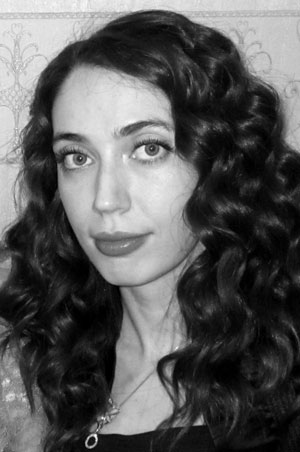The influence of physical loadings on cognitive functions of students
Фотографии:
ˑ:
L.Sh. Bedanokova, postgraduate
Adygei state university, Maikop
Key words: methodology Р300, cognitive evoked potentials, basketball players, judokas.
Introduction. Training of the fast decision-making ability in the rapidly changing playing environment lays the basis of individual enhancement of athletes' skills. According to literature data [7], sports classes, specifically basketball, allegedly result in the shorter latent time of the complex motor conditioned reflex reaction, requiring selection of the right answer, first of all, by decreasing the time spent for taking a decision. Only the p300 indicator is usually considered in domestic and most of the foreign studies, as a response to auditory stimuli. It is interesting to consider both p300 components (P3a and P3b) as a response to not only auditory but also to visual stimuli to reveal the most developed sensory specific system in athletes depending on sport specialization. It is known, that the P3a secretion allows to evaluate the recognition process, while the P3b component of cognitive evoked potentials is considered as an electrophysiological correlator of the decision making process and it is being registered with the presentation of significant stimuli that require attention concentration [5,8]. According to the literature, lower latency levels of P3b, as well as the amplitudes and latencies of P3a along with higher amplitudes of P3b indicate the development of qualitative and quantitative parameters of cognitive processes, activity and coherence in the neuronal populations involved in the recognition processes and decision-making [1,4].
The purpose of the study was to determine the influence of physical loadings on students' cognitive functions in respect to their sports specializations and qualifications.
Materials and methods. Cognitive indicators were determined using the "Neuro-MVP-8" software complex ("NeuroSoft" company, Ivanovo town) according to the p300 methodology in the random event situation ("odd-ball" paradigm). The methodology was carried out with the use of stimuli of varied complexity and modality (reversive staggered pattern, tone click, LED flash).
15 judokas (masters of sports and candidates to master of sports; sport experience - 8,9±0,5 years), trained at the Institute of Physical Culture and Judo of Adyghe State University; 15 students, basketball players in the sport sections mode at Adyghe State University (I and II adult category; sport experience - 3,8±0,5 years) were involved in the study on the voluntary basis and formed the experimental group (EG). The control group consisted of 20 2-4-year students of the department of natural sciences of Adyghe State University with a traditional motor mode (2 hours of physical education per week).
All the examined students were 18-20 year old males, right handed with right-sided stand, with minimal differences in anxiety and intellectual development levels: moderate anxiety according to Lusher test, medium reactive anxiety according to Spielberg test, medium level of the Wechsler IQ (WAIS-R).
The choice of the electrodes location was based on the study of works of V.V. Gnezditsky 2001[4]; V.I. Giger-Mateeva et al., 1999 [10]; J. Polich, 2007 [13].
The separated averaging of the responses in the pseudorandom sequence (the occurrence probability 30%) to rare significant (at least 30 stimuli) and frequent insignificant stimuli was made automatically.
The statistical data analysis was made using "Statistica 7.0" software package, "Microsoft Office Excel 2007" and "OriginPro 8.1".
Results and discussion. At the auditory stimulation the latency indicator P3a in a group of student-basketball players was reliably lower (p<0,01) compared to the CG and the group of qualified judokas. The higher rate of recognition of auditory stimuli among the student-basketball players is explained by the fact that in basketball the voice messaging of the players between each other and the trainer is trained and used in the game more often than in judo.
The P3a indicator values as a response to the reversive staggered pattern and a LED flash didn't have any significant differences (p<0,05) showing the similar rate of recognition of these stimuli in these student groups.
At the same time, the observable tendency of the latency indicators P3a exceeding when the auditory stimulation and the staggered pattern stimulation of the qualified judokas compared to basketball players and the CG (Fig.1.) is explained probably by the fact that they have higher concentration on the proprioceptive sensations, as a priority in conditions of contact fight, and by the activation of the descending inhibitory effects on sensory specific areas of other stimuli. It should be noted, that there is no such exceeding of P3a indicator in case of the LED flash stimulation, that is explained probably by the absence of sensory specific areas and inhibitory mechanisms for this type of an incentive.
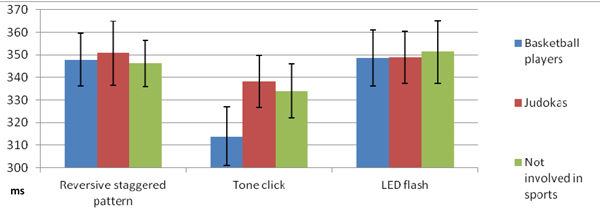
Fig.1. Latency indicators P3a of the students involved (basketball, judo) and students not doing sports.
When using only tone clicks, there was a tendency of P3a indicators improvement of the basketball players compared to qualified judokas. It must be assumed that functional organization of the sound perception system of the basketball players is better formed in the process of training and competitive activity. That makes it significantly easier to differentiate the auditory signals, accelerates the possibility of fast decision-making and provides the successful solutions of the auditory tasks.
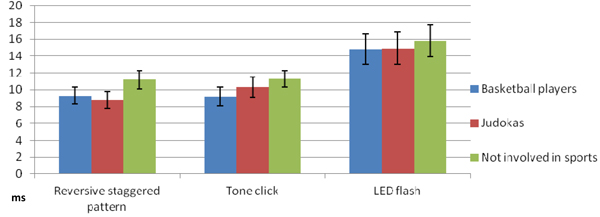
Fig. 2. P3a amplitudes as a response to different types of stimuli of the students involved (basketball, judo) and students not involved in sports
P3a amplitudes as a response to LED flash didn't have any significant differences (p<0,05) between basketball players and qualified judokas, indicating the similar easiness of these stimuli recognition regardless of sports specialization and students’ qualification. At the same time, there was a clear tendency of the P3a indicators improvement relatively to the students not involved in sports. Lower P3a amplitudes at the auditory stimulation and the staggered pattern stimulation of the students involved in sports can be explained by the higher development degree of differential inhibition [15].
It was found, that the latency P3b of the basketball players upon presentation of all types of stimuli (reversive staggered pattern, tone click, LED flash) is lower (Fig.3.) than those of the judokas (p<0,01) and the students not involved in sports (p<0,01). It means that despite the high qualification of judokas, students, who played basketball in sports sections, had better indicators of a rate of decision-making. Probably, it is explained by the importance of evaluation of the non-verbal sound stimuli during the attack from behind (out of sight) and the necessity of quick responses to changing players location and ball movement. It cannot be ignored, that the voice communication of players between each other and the trainer during the game provides better results on the field and that's why it is fixed in their behavior as a useful skill. The difference of the latency indicator P3b of the basketball players compared to students not involved in sports (p<0,01) and the absence of any significant difference between judokas and students not doing sports can be explained by the fact that basketball players have the most developed ability to evaluate the distance to the object [6]. This ability is inseparably linked with the object' size evaluation due to the implementation mechanism. In this regard, the distinction of the squares' size of staggered pattern activates the well-trained visual sensory system of basketball players.
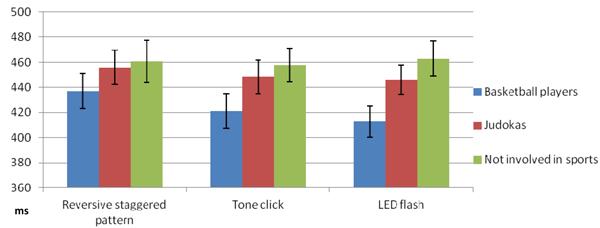
Fig. 3. Latency indicators P3a of the students involved (basketball, judo) and students not involved in sports
The analysis of P3b amplitudes has revealed better results (p<0,01) of the basketball players and judokas upon the presentation of all types of non-verbal stimuli (reversive staggered pattern, tone click, LED flash) compared to the students (Fig.4.). So it can be assumed that the students involved in basketball and judo coped more easily with the decision-making in presented tasks than students not involved in sport. The basketball players, at the same time, upon the presentation of reversive staggered pattern and auditory tone clicks, had the P3b amplitude with a tendency to higher values compared to qualified judokas (p<0,05).
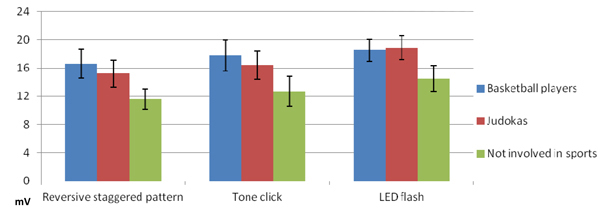
Fig .4. R3b amplitudes to different types of stimuli of the students involved (basketball, judo) and students not involved in sports
According to the literature, the individuals less disposed to domination [12] and men with greater physical activity [9] have higher P3b amplitude. It explains exceeding the amplitudes of basketball players, because in team games the domination, as a characteristic, is less developed than in combat sports, and lower P3b amplitudes of students not involved in sport compared to students involved in sports.
Some authors associate higher P3a amplitudes of people involved in sports with the simultaneous organized discharging of a large number of neurons (provided by the neuron cells' lability increase), the rise of lability and neural processes mobility, the reducing of the carrying time through interneuron synapses [2, 3]. Yu.E. Koryukalov [2] noted in groups of athletes the synchronization of rhythmic activity in the EEG, accompanied by the increase in intra- and inter-hemispheric functional connections within various cognitive tests. According to the concept of R.T. Knight et al. (1989) higher P3b amplitudes are associated with greater involvement of hemispheric comparison of the sensory information [11].
In the study with LED flash the P3b amplitude of students not involved in sports was lower (p<0,01) than that of the basketball players and especially of the qualified judokas. It is known that the lower P3b amplitude, the poorer quality of detection and identification of the target incentive itself [5]. One of the reasons is that the decision-making skill in response to LED flash can't be learned in everyday life. It is known also that the P3b amplitude changes are related with the task specifity, which requires a choice of a right answer and depends on intensity of the energy used in a complex conditioned reflex motor response [3, 14]. In addition, more complex the differentiation promotes greater generalization and higher amplitude [8]. It can be explained by the fact that P3b amplitudes in response to LED flash were individually the highest in each group. This must explain the fact that it was the most difficult task for every student, regardless of sports specialization, qualification and the mode of physical activity.
The obtained results have proved the importance of monitoring of individual characteristics of cognitive evoked potentials, for they provide for estimation of the dynamics and manner of enhancement of athletes’ skills and so can serve an objective evaluation criterion for correction of the training mode and qualification for competitions.
Conclusions:
1. If showing all three stimuli the process of decision-making was easier for student-basketball players and judokas rather than among students not doing sports.
2. Student-basketball players recognized auditory stimulus faster than qualified judokas and students not involved in sports.
3. When using all three types of stimuli student-basketball players took decisions faster and easier than qualified student-judokas and students not engaged in sports.
4. The decision-making time is significantly related with sports specialization. Regular judo and especially basketball classes bring the neural network of the relative sensor specific cerebral system to a higher lability level, providing for the rate of recognition and decision-making processes, that is sensory information analysis.
References
- Kapilevich, L.V. Visual and cognitive cerebral evoked potentials in athletes / L.V. Kapilevich, E.V. Zamulina, V.G. Shil’ko // Teoriya i praktika fizicheskoy kultury. 2007. – № 3. – P. 59–61. (In Russian)
- Koryukalov, Yu.I. Bioelectrical processes in the cerebral cortex at different functional states of young boys at the age of 18-25 years old: abstract of Ph.D. thesis / Yu.I. Koryukalov. – Chelyabinsk, 2008. (In Russian)
- Neurophysiological diagnostics and treatment of cognitive defects at neuropathies among children: Guidelines / S.K. Evtushenko, T.M. Morozova, A.A. Omel’yanenko [et al.]. – Donetsk, 2010. (In Russian)
- The experience of use of evoked potentials in the clinical practice / Ed. by V.V. Gnezditskiy, A.M. Shamshiova. – Moscow: MBN, 2001. – 480 P. (In Russian)
- The display of individual specifics of temperament in characteristics of behavioral responses and cognitive evoked potentials in the attention situation / B.V. Chernyshev, V.E. Bezsonova, E.G. Chernysheva [et al.] // Psikhologicheskiy zhurnal Mezhdunarodnogo universiteta prirody, obschestva I cheloveka “Dubna”. – 2011. – № 3. (In Russian)
- Rovniy, A.S. Sensor control mechanism of human accuracy movements: monograph / A.S. Rovniy. – Kharkov: KhaDIPC, 2001. – 220 P. (In Ukrainian)
- Sologub, E.B. ECG and psychophysiological characteristics of athletes with different styles of competitive activity / E.B. Sologub // Human physiology. – 1993. – V. 19. – № 1. – P. 10–14. (In Russian)
- Khomskaya, E.D. System changes in the cerebral bioelectrical processes as a neurophysiological basis of mental processes / E.D. Khomskaya // Natural scientific basis of psychology / Ed. by A.A. Smirnov, A.R. Luriy, V.D. Nebylitsyn. – Moscow: Pedagigika, 1978. – P. 234–253. (In Russian)
- Aging, physical activity, and cognitive processing: an examination of P300 K. McDowell, S.E. Kerick, D.L. Santa Maria [et al.] // Neurobiology of Aging. – 2003. – Vol. 24 (4). – Р. 597-606.
- Isolation of late event-related components to checkerboard stimulation / V. Giger-Mateeva, F. Riemslag, D. Reits [et al.] // Electroencephalogr. Clin. Neurophysiol. – 1999. – Vol. 50. – P. 133-149.
- Knight, R.T., Scabini, D., Woods, D.L. et al. Contributions of temporal-parietal junction to the human auditory P3. Brain Research. 1989; 502:109-116.
- Pavlenko, V.B., Konareva, I.N. Individual Personality-Related Characteristics of Event-Related EEG Potentials Recorded in an Experimental Situation Requiring Production of Time Intervals // Neirofiziologiya / Neurophysiology. – 2000. – Vol. 32. – P. 48–55.
- Polich, J. Updating P300: An integrative theory of P3a and P3b // Clinical Neurophysiology. – 2007. – Vol. 10. – P. 2128–2148.
- Reactivity and event-related potentials during attentional tests in athletes / G. Fontani, D. Maffei, S. Cameli [et al.] // Eur J. Appl. Physiol. – 1999. – Vol. 80. – Р. 308–317.
- Visual P3a in male alcoholics and controls / S. Rodriguez Holguin, B. Porjesz, D.B. Chorlian [et al.] // Alcohol Clin. Exp. Res. – 1999. – Apr. 23 (4). – Р. 582–591.
Author’s contacts: coralmed01@yandex.ru

